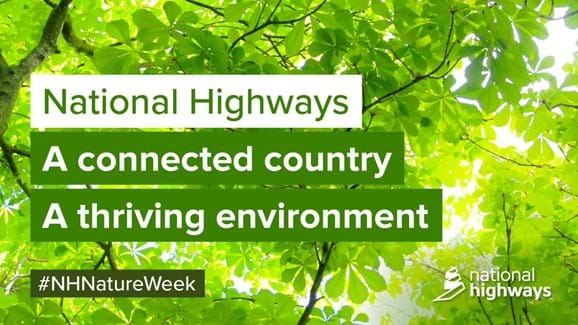Planting new homes for nature, off the A1
Published
22 May 2023
This year we've planted over 5000 trees and shrubs in Yorkshire as part of our commitment to increase tree cover near our road network.
Share this article
We're highlighting some of our nature focussed work near and on our road network, during our Nature Week in May. National Highways is one of the country’s largest landowners, with 30,000 hectares of green land. Roadside verges and nearby land and wetlands are home to diverse wildlife, insects and natural habitats.

This year land close to the A1, which falls within the White Rose Forest the Northern Forest, was planted with more than 5,000 trees and shrubs in North and West Yorkshire by National Highways.
We’ve planted a range of native broadleaved species at five locations, north of Leeds, close to Micklefield, South Milford and Fairburn; the aim is to increase woodland cover in the region as well as providing a wide range of other benefits.
Our planting sites include a mix of natural habitats close to road drainage ponds and verges. Species include English Oak, which supports more biodiversity than any other tree species in the UK, Field Maple, a broadleaf attractive to caterpillars and aphids and a species which resists air pollution and Hazel, which has long been associated with pollen for bees and food for woodpeckers, nuthatch, and dormice.
Tree canopy cover in this part of the country is just over seven and a half per cent, considerably lower than the national average of 13 per cent. The saplings we have planted will in time act as carbon sinks. They’ll provide much needed habitat connectivity for wildlife and improve soil stability as well as slow the flow of flood water on to the road network.
We’re not just planting for the landscape. We’re planting for ecology as well, developing a green corridor to link our cities and our wildlife.
The White Rose Forest is the community forest for North and West Yorkshire, working in partnership with local authorities, landowners, businesses, and communities to increase woodland across the region. It is the largest of England’s thirteen community forests and part of the Northern Forest that will stretch from Liverpool to the Yorkshire coast.
The planting has been funded from National Highways’ Environment and Well Being Designated Fund, which supports the company’s vision of a greener, more sustainable road network.
The Northern Forest is a joint initiative between conservation charity The Woodland Trust and four community forests in the north of England, The Mersey Forest, Manchester City of Trees, the White Rose Forest, and Humber Forest. It will see the planting of at least 50 million trees over the next 25 years, that will help transform the landscape from Hull in the East to Liverpool and Chester in the West. Since 2018 more than three million saplings have gone in the ground.
You can discover more about our approach to the environment and biodiversity in our Environmental Sustainability Strategy
